Official Name
Prizren; alternatively spelled Prizreni in Albanian (meaning "The Prizren"). With cyrillic letters, the town is written Призрен (Prizren), but since Prizren is out of reach for the Serbian government, the cyrillic spelling vanished. In Roman times, the town was known as Theranda, and this name can still be found around the town.
Location
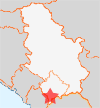
| ||
| Prizren / Kosovo |
Prizren lies in the southwestern corner of the Kosovo - to be exactly in the region Metochia (see →Kosovo for more details). Geographically, Prizren is the southernmost town of Serbia, although it is not under Serbian control any longer. The town sprawls in a beautiful valley along the small river Bistrica e Prizrenit, Serbian: Prizrenska Bistrica. In the south, the up to 2,000 m high, rugged mountains of the Malet e Sharrit / Šar Planina dominate the skyline. In the west, it's the almost alpine Bjeshkët e Nemuna / Prokletije mountain range with some more then 2'600 Meter high mountains.
Prizren lies in the heart of the province with the same name - it's the sector in Kosovo which is controlled by German KFOR forces. It's only around 15 km to the border with →Macedonia in the southwest, but unfortunately there is no border crossing nearby. The border crossing to →Albania in the west is also only 15 km away. To the capital Priština it's more then 100 km.
Population
Prizren is a larger town with around 110,000 inhabitants. Almost (?) all Serbs and also Roma were driven out the town - now, Prizren is dominated by ethnic Albanians and a Bosniak minority. The district of Prizren has around 220,000 inhabitants.
Orientation
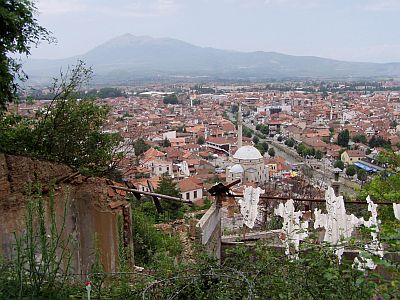 | ||
| View on the centre of Prizren from the fortress |
Two things dominate the town - the small, almost dead-straight river Bistrica e Prizenit and the beautiful fortress Kalaya on the top of a steep hill. The historic centre of town stretches on both sides of the river right below the fortress, which makes it easy to find. There is no train station in town. The main bus terminal can be found at an arterial road in the northwest of town. The centre itself offers a unique combination of old Bazaar atmosphere, Serbian orthodox churches and some rather unattractive newer buildings. Unfortunately, one district was looted and burnt to the ground - for more information see below.
History
Prizren is a very old town - if not one of the oldest towns in Europe. One of the reasons for this might be the good location - the favorable climate in the valley and the fact that this was the place were some important trade routes met, made Theranda, as it was called then, soon became a thriving place.
During the 7th century AD, first Slavic tribes arrived in the area. Among them were the Serbs, who were about to dominate the area for the centuries to come. Prizren was even declared the capital of the Kingdom of Serbia for a while. However, it was also conquered by →Bulgaria once. In 1389, Serbia was defeated at the decisive battle at the nearby Kosovo Polje ("Blackbird field"). This event marked the beginning of the long Ottoman supremacy. Large parts of the town - including the impressive fortress were to be erected by the Ottomans within the next centuries. Prizren was declared capital of the province and gradually increased its importance, which was not longer limited to the area nearby
In 1878, the League of Prizren came into being: The declared goal was the independence of Albanians from the Ottoman empire (for more information see →History of Albania). But despite the movement, the town was to remain under Ottoman rule until 1912 - and then conquered by the Serbs. According to historical sources, the occupation of the town was bloody - the Serbs reportedly committed several atrocities against the Albanian inhabitants. In 1914, Austria-Hungary took the town from the Serbian occupants. And in 1916 it was the Bulgarians who took control. But only for two years - in 1918, Prizren again became part of Serbia or the Kingdom of Serbs, Slovenians and Croatians respectively, which should later be known as Yugoslavia.
The rest of the history is deeply connected to the history of the entire Kosovo: Although Albanians formed the majority, Kosovo could not gain the status of a republic inside Yugoslavia. All it got was the status of an Autonomous Province. Economically, the situation was the worst in entire Yugoslavia. And the status of autonomy was later withdrawn. In 1999, several events led to a deep crisis - almost all Albanians were expelled from the town and the surrounding area by the JNA (Yugoslav National Army), again involving assaults and atrocities against ethnic Albanians. Until the NATO intervened. Albanian inhabitants soon returned to town, which was then under UNMIK and KFOR resp. control. Victims quickly turned into actors, expelling Serbs as well as the Roma. After that was done, it remained quiet for some years, until violent unrests suddenly outburst on 17 March 2004. At that time, there were still around 10% Serbs in town. During the unrest, the Serb district as well as almost all Serbian-Orthodox churches were looted and burnt to the ground. For more information and pictures, see below.
Getting there / transportation
Prizren is not connected to the railroad network, but it has good bus connections. Dozens of buses a day shuttle between Prizren and the capital of Kosovo, →Prishtina. The trip costs € 3 and takes around 1½ hours. Long-distance buses run as far as →Turkey and some other, mainly Islam countries - just check the several bus companies in the bus terminal. There are three departures a day to →Tirana - two in the morning at 7 and 8 am, and a third one at 9 pm. The fare is € 15 Euro. Take the morning bus, or else you'll miss a spectacular scenery.
Getting to →Kukës, which is only 30 km away and the first larger town in →Albania), is not that easy, but it's possible to jump on the bus to Tirana - but despite the small distance, the fare is still € 10. Of course it's also possible to hitchhike (which I did, and it didn't even take an hour), but I cannot really recommended hitchhiking in this area since the border area is still considered unsafe.
Prizren lies in a beautiful valley, framed by more or less high mountains with a small, purling river called Bistrica e Prizrenit, Serbian: Prizrenska Bistrica running through the centre of town and an old fortress, or at least what's left ofit - towering high above the vivid old centre. And it is a very vibrant town - at least in summer, it appears that virtually everyone is flocking around the streets in the heat of the day and also at night - just wandering around or sitting in cafés, watching the never ending crowd as it moves through the lanes.
In certain distances, small bridges span the river. The most beautiful of them lies right in the heart of the town and is called Ura e gurit (translated Stone Bridge !?). It's a typical Ottoman arch bridge as it can be found in →Skopje and many other places in the Southern Balkans and Turkey. South of the bridge starts the most vibrant district with countless restaurants and cafés, some of them lining up along the river.
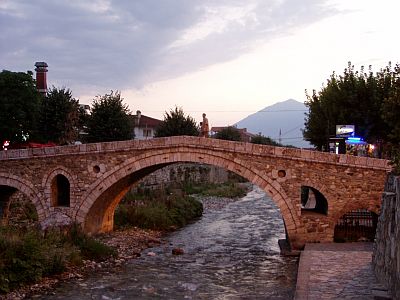
| ||
| The small but beautiful bridge in the centre of Prizren |
Many remnants of the very long Ottoman foreign rule can be found in Prizren, although the town also serves as a symbol of the struggle of Albanians against the Ottomans. Especially the bazaar-like district with its tiny, crouched houses and the numerous mosques makes the visitor feel like walking through an oriental town. Prizren is home to Kosovo's largest mosque - which is called Sinan Pasha mosque and close to the river. The building was erected at the beginning of the 17th century, and of course it's still used as a mosque.
As someone would expect from a formerly Ottoman town - the Ottoman rule lasted until the beginning of the 20th century - the town has its own proper Turkish bathhouse (Hamam), called Mahmet Pasha Aman. It's a little bit tucked away between modern buildings north of the river but still in the centre. Next to it stands another mosque. The Hamam was built around 1561. The large Ottoman fortress Kalaya on the top of a steep hill was unfortunately razed at some point in its long history. But the remainings of the massive outer walls give an idea how mighty the structure was once. It's definitely worth climbing the hill all the way to the fortress - the view from there is splendid. The entire town and the surroundings in the front, with the Albanian Northern Alps in the back, can be overlooked from the hilltop.
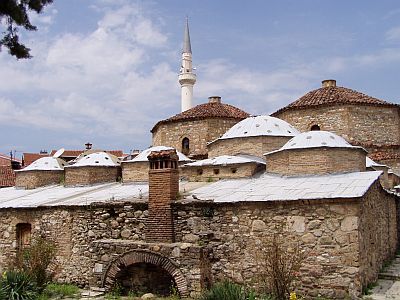
| ||
| Prizren: The Mahmet-Pasha-Bath |
Seeing all those marvellous things it makes the visitor almost forget where he/she actually is. But why is there so much military in the town - most of them from the German army? Heavily armed soldiers and armoured vehicles are omnipresent - again, most of them carrying the German flag, but also some from Turkey and even the Switzerland (weren't they neutral!?). In the centre of town, near the sights, in the outskirts - the army is everywhere. Sometimes surrounded by mostly female Kosovo citizens asking for a picture with them. All of this already suggests that the peaceful atmosphere is a fallacy. A view on the district Podkalaya (Castle Town) between the river and the fortress reveals the sad truth: The war with all of its horror is not far away.
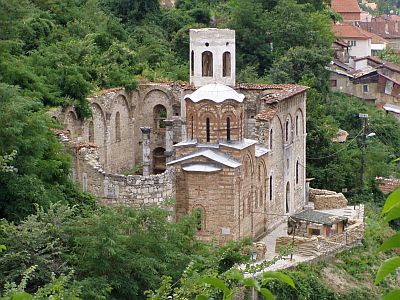
| ||
| Destroyed Serbian monastery - now an army post |
After the retreat of the Serbs in 1999 and the following move in of international KFOR troops, things seemed to calm down in the area. Also in Prizren. The town was not only an important Ottoman provincial town but also the spiritual centre of the Serbian-Orthodox church. This role was expressed in several Serbian-Orthodox churches, monasteries and seminar. It was obviously a well-planned action when suddenly thousands of Serbian churches and houses were looted and burnt down within two days only - on 17 and 18 March 2004 - all over the Kosovo. Additionally, many Serbs were murdered or wounded. Today, the ruin of a once important monastery below the fortress is used as an observation post by the German army. Getting to the fortress is not as easy as it looks like - parts of the burnt-down district on the way to the hill are off-limit to everyone. The shortest way runs via the above-mentioned ruin.
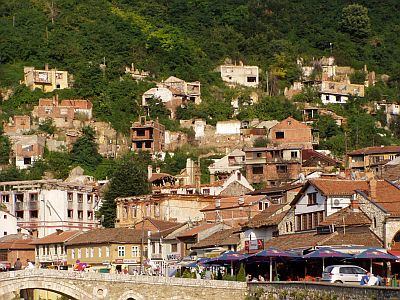
| ||
| A shame for the whole town: The looted and burnt down Serbian district Podkalaya |
Prizren is a really fascinating place and definitely worth the visit, if there wouldn't be the eyesore right in the heart of the town. It's not that every citizen is proud of the events - one man told me that he was very ashamed that this (the looting and burning of the Serb quarter and churches) happened - "of all things after peace finally came back". Of course it should not be forgotten what Serbian troops did to the Albanians in this area. Mass expulsion, ethnic cleansing, atrocities with countless victims. Unfortunately, Albanians took revenge the same way. Prizren is one of the places where the dream of a multiethnic society bursted with a bang - to be buried thereafter. Prizren wasn't the first place in Ex-Yugoslavia where this happened. After all, it's one of many places.
Official Name
Internationally, the region is known as the Kosovo. However, the historically correct, Serbian name is Косово и Метохија (Kosovo and Metohia). Kosovo derives from the word Kos = blackbird, which is why the central valley Kosovo Polje is sometimes referred to as "Blackbird field". Metohia (also: Metochia) is a Greem term, which simply means monastery. Another name, occasionally used for the area, is "Kosmet".
The Albanian name for the area again derives from the Serbian name and is spelled Kosova. Since Kosovo is the most common name used abroad, I'm referring to the area on this website as "Kosovo" - which doesn't express any political point of view.
Area and population
The Kosovo is only 10,887 km² large but has almost 2 million inhabitants. Which is an unusually high population density in the wider area - especially when considering the fact that there's not much arable land. Since 1999, the share of the Albanians gradually grew bigger - today, around 90% of the population are ethnic Albanians, Serbs are only around 5% and that is still decreasing. After the war, many Serbs left the country on their own or were expelled. Serbian communities mainly concentrate in the North of the Kosovo and in some smaller exclaves in the South and the East.
Travel Information
Kosovo unilaterally introduced the Deutschmark, later the Euro as their currency. ATM's can be found in larger towns, accepting most common credit cards as well as Maestro cash cards.
Prices are comparetively low in Kosovo, but there's still a lack of affordable accommodation in many places - no surprise, since this is not a typical tourist destination. Food ranges from inexpensive to luxurious, but in most places it's possible to have a good diner for less then € 5.
The Kosovo shares borders with →Albania in the West, →Macedonia in the South, →Serbia in the North and East and with →Montenegro in the Northeast. There are several ways to get into the area without taking a plane - for example from →Kukës (Albania) to Prizren, from →Ohrid (Macedonia) to Prishtina and from →Novi Pazar (Serbia) to Prishtina. Warning: Traveling from Serbia to the Kosovo is no problem at all if it's a regular crossing. But it can be a problem when travelling from Macedonia, Montenegro or Albania to the Kosovo and then to Serbia: When entering and leaving the Kosovo won't be stamped - but it will be stamped when entering and leaving Serbia from other countries. Which means that, according to Serbian law, it is an illegal entry into the country.
I travelled the route Serbia-Kosovo-Serbia or Serbia-Kosovo-Albania-(Montenegro - it wasn't independent then)-Serbia and it was ok, but probably only because my passport was almost full with dozens of different stamps, so they didn't check the entire passport.
There are several international flight connections to the capital Prishtina - especially from Germany, Switzerland and Austria. Probably the safest and most relaxed way to travel to the Kosovo.
The author's point of view
Historically spoken, Kosovo is Serbian heartland - at least since the 7th century. Later, more and more Albanians moved into the area. Hostility between Serbs and Albanians is by far new phenomenon - there have been massacres centuries ago as well.
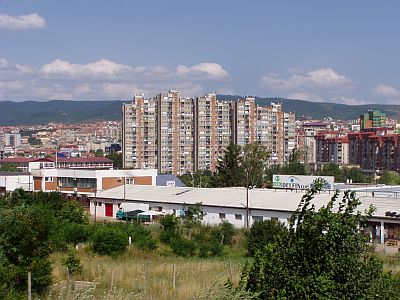
| ||
| Prishtina, capital of the Kosovo region |
It's a fact that Albanians faced an increasingly hard time after Yugoslavia stripped the area of it's autonomy status in 1989. But even before, the economic situation in Kosovo was by far the worst in Yugoslavia. Kosovo was a remote, deliberately forgotten corner of the country. It's also a fact that the Serb dominated JNA (Yugoslavian National Army) caused much suffering among the civilians - many were brutally expelled from their homes, if not even killed. After hesitating for a while, the UN decided to interfere and sent in jet fighters. Later on, after the Serbs were forced to leave, the UN placed KFOR troops all over the area to put an end to the short but bloody war.
This created an absurd situation. Suddenly, huge amounts of money were pumped into the Kosovo - partially thanks to international campaigns but also thanks to the fact that many Kosovarians fled the country after 1989, working in Germany, Switzerland etc. and sending money home. Kosovo at the same time also became the haven for shady businessmen. The sudden boom started under the supervision of the KFOR, far, far away from the capital →Belgrade, which is de facto still the capital of Serbia including Kosovo although it doesn't have any influence any longer. Meanwhile, Albanians tried hard to create facts by expelling Serbs from their ancient homes, burning down churches and monasteries and more. As a result, it can only be said that the UN policy has failed completely - the war did not really stop - it only turned victims into actors and vice versa. One day, one part of the population was extremely poor and without any perspective - now, it's the other part.
As a visitor, the question arises how this is supposed to go on. A simple look at the map - the land-locked position in the Balkans, the mountainous area - shows that the Kosovo can't exist completely on its own. Not enough arable land, too many inhabitants. There's also the lack of other significant natural resources such as ore for example. The industry is on a very low level. If KFOR troops would be withdrawn over night, the area would experience another bloodshed. Unification with Albania, as some foreign sources speculated? No way. Several people from Kosovo told me that this is no option - the way Kosovo people think about their even poorer Albanian neighbours is not very good. Remaining a part of Serbia? Hard to believe. And so, the Kosovo will remain an open issue on the Balkans.
In the afternoon of 17 Feb 2008, the Kosovo parliament unilaterally declared full independence - a decision that was anticipated by many European countries. The declaration, as expected, triggered protests in Serbia. Russia as well is strictly against an independent Kosovo.
North of the central bridge, the one in front of the large mosque, are two hotels facing each other. The one on the right side - when looking from the bridge - is called Hotel Tirana, and it's a rather old establishment. However, it's comparetively expensive. A better bargain is the Hotel Theranda on the left side next to the post office. A single room there costs € 15 per night. Rooms are large and clean, and they offer a nice view... on the looted Serbian quarter on the other side of the river. The location right in the centre of course is perfect. Some of the staff members speak English. The road in front of the hotel is called Adem Jashari rd.
- www.prizreni-komuna.org: Official website of the city of Prizren. As of 2005 not really helpful and in Albanian, Turkish and Serbian/Bosnian only. Exactly. What's English anyway.
- www.nato.int/kfor: Official website of the KFOR contingent.
- en.wikipedia.org/wiki/Kosovo: Kosovo on Wikipedia: Includes tons of information and many links - with the latter divided into pro-Albanian and pro-Serbian links, which is very helpful.
- www.kosovo.com: As of 2005, this was a very pro-Serbian website about Kosovo. It also included propaganda, but not only - it was an interesting way of getting the Serbian point of view. In 2008, this domain seemed to have vanished, so let's see what will come up next here.
Do you have or do you know a good website about Prizren and/or the Kosovo? Don't hesitate, let me know! After checking it, I would love to add it to the link list. You can submit a link by using the →contact form. Note that commercial websites will be treated differently.
©2024 Europe-East.com

 Albania
Albania Serbia
Serbia